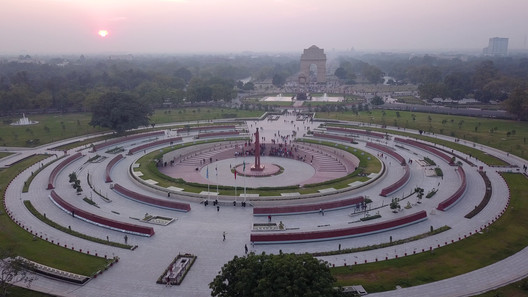The concept of rebirth is inspired from the quote of Captain Vikram Batra
Either I will come back after hoisting the Tricolour,
or I will come back wrapped in it,
but I will be back for sure.

REBIRTH – पुनर्जन्म (in Hindi)
‘Reborn to be an immortal’.
Invisible but strongly present.
The NWM is the spatial manifestation of the idea of rebirth, gestated on the stories of, the life and struggle of unsung soldiers who have sacrificed themselves for the sake of nation. Culminating the Raj Path of the Lutyens Delhi, behind the India gate, this semi-subterranean intervention, spreads over 42 acres in the C- hexagon, retaining the identity as “people’s place” and embracing the memory of love, affection and pain. Each fallen soldier is imagined as a brick in the process of nation building and arranged as a series of concentric rings, symbolizing the act of protection, sacrifice and bravery culminating in the immortal presence in the form of eternal flame.


Six decades of void:
The request for the National War Memorial (NWM), India was placed by the armed forces in 1960. However, the consideration acquired momentum in 2015 and the construction was approved within the National capital’s heritage zone of the British Imperial Times. Later, an International two stage competition was held for the design and implementation of the NWM by the Ministry of Defense, Government of India. WEBE Design Lab won both the first and the third place. The winning entry headed by Ar Yogesh Chandrahasan was commissioned for construction. India’s NWM was finally inaugurated on 25th Feb 2019 by Honorable Prime Minister Narendra Modi.



CONTEXT AND DESIGN APPROACH – The Iconic India Gate, brims with an average footfall of 50,000 ppl/day. Inset within the bustling C Hexagon the lawns were retained to be active public spaces to play, meet, relax and more. This Capitol complex has a central axis, the Rajpath- The ceremonial path from the President’s home, that runs across and ends at the India Gate. The newly built NWM retains the axis and bestows the essence of hierarchical importance upon the overall footprint. A cross-connection at the core of the New Memorial: The Yudhpath– is a metaphorical placement of the Rajpath (Path of life) with the Yudhpath (Path of war).


Circle of Sacrifice (Tyag Chakra): Inspired by the historic “Chakravyuha” Ancient war formation, the Tyag Chakra is arranged in concentric circles in accordance with the wars, gloriously housing the names of 25,700 war heroes, who sacrificed their life post-independence for the Nation. It is a concrete structure, with self-interlocking granite blocks placed over it. Each block represents a Martyr, and is engraved with his name, rank and number.


ESTABLISHING SYMBOL AND MEMORY –
Circle of Protection– The tree arrangement personifies the territorial line of control- The soldiers who are still there trying to safe guard us in places unseen. The circle containing 690 trees also helps in screening the busy roads of the C Hexagon thereby creating a calmer and protected space inside the memorial.
Circle of Bravery (Veer Chakra) – A semi open corridor and gallery holding the brave stories of significant historic battles in Indian history of the Army, Navy and Air force.
Circle of Immortality (Amar Chakra)- The obelisk carrying the eternal flame symbolizes the immortality of the Jawans that they will never be dead and they will always live in our memory. It is set in a larger circular court which also is the ceremonial space.










Lighting: The lighting in the central court around the eternal flame spearheads sideways and up building a sense of eternity as it fades out. The Thyag chakra seems floating with a series of small lights which resembles the oil lamps that are light in memory of the beloved ones in any Indian home. The streaks of light on the steps create a sense of transition through the concentric setup. The project does not have any ambient light.
As much as the light brought in emphasis and character, the darkness made the required experience deeper and absorbing.






Project Facts
Location: C- Hexagon, Lawn 1,2 ,3 4, Central Delhi, India
Site Area: 42 Acres
Year of completion: March 2019
Client: Ministry of Defence, Government of India
Design Firm: WeBe Design Lab, Chennai
Lead Architect: Yogesh Chandrahasan
Design Team (WeBe)
Yogesh Chandrahasan, Visuwanathan, Satish Vasanth Kumar, Udhayarajan, Malli Saravanan, Ranganathan Ravi, Anjana Sudhakar, Kamal Rajkumar, ViJaya Prakash, Balachandar Baskaran, Abhishek Tiwari







